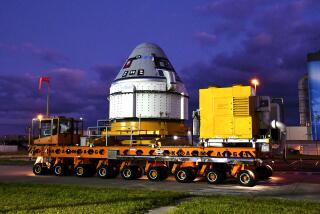Fuel Leaks on Shuttles Appear Unrelated : Space: The glitches are in different parts of the Atlantis and Columbia systems. That makes fixing them easier, NASA says.
- Share via
KENNEDY SPACE CENTER, Fla. — The hydrogen leaks crippling space shuttles Atlantis and Columbia appear to be in different places, ruling out the possibility that the problems are related, NASA said Friday.
“The things that we know leak on one we know aren’t leaking on the other,” said William Lenoir, head of NASA’s space flight program.
A common problem with the shuttles’ fuel system would have been much more difficult to deal with, said shuttle director Robert Crippen.
Early indications after an elaborate test of Atlantis’ fuel system Friday are that hydrogen escaped from a flange on the external tank side of a 17-inch-diameter valve, Lenoir said. The valve is in a pipe that carries fuel from the tank to the main engines.
No leaks were found in that area on the plumbing from Columbia that was sent for laboratory testing to shuttle builder Rockwell International Corp. in Downey, Calif., Lenoir said.
Lenoir said the problem with Columbia has been corrected since new plumbing was installed in the faulty area. The new components were taken from the shuttle Endeavour, under construction in California.
It’s too soon to say how NASA will deal with Atlantis’ leak, Lenoir said.
The solution may be as simple as tightening the seal, which could be done at the launching pad. Putting in a new seal would require a return to the hangar, he said.
NASA wants to launch at least one shuttle before Discovery’s scheduled flight with the sun-exploring Ulysses satellite in October, Crippen said. The most likely candidate is Atlantis, on a classified Defense Department mission.
Discovery has until Oct. 23 to lift off with Ulysses because of the alignment of Earth, the sun and Jupiter. Otherwise, the flight must be delayed for 13 months.
Lenoir said there is no reason to believe that Discovery has a leak. It is uncertain whether that shuttle will undergo a tanking test before launching, he said.
Columbia’s leak was discovered during fueling for a May 30 launching attempt. A test a week later duplicated the leak, and the shuttle was returned to the hangar for repairs.
As a precaution, NASA conducted a similar test on Atlantis on June 29 as the shuttle awaited a mid-July liftoff. A leak was detected, and the agency grounded the three-shuttle fleet.
It was the first time all of the shuttles had been grounded since the 1986 Challenger explosion. The next shuttle did not fly until 1988.
In Washington, meanwhile, NASA Administrator Richard H. Truly admitted Friday that mirror flaws blurring the Hubble Space Telescope’s view of the universe could have been detected by a simple, safe and inexpensive test.
“With hindsight, we can determine that a test could have been done that would not have had the potential of contaminating the mirror and would have found this aberration,” Truly told a congressional committee.
Previously, space agency officials had said they had not conducted a test of the $1.5-billion telescope as a whole, which could have detected the crippling mistake, because it would have been very expensive and risked contaminating the pristine mirror.
It is unclear which would have been the best test to detect the flaw and why such a test was not conducted, they said. A panel probing the blunder should determine exactly how the error occurred and why it was not detected before the telescope was placed into space on April 25, they said.
Truly acknowledged that the problem with the telescope and the subsequent grounding of the space shuttle fleet due to a fuel leak had “eroded” public confidence in the agency.
But Lennard Fisk, NASA’s associate administrator of space science and applications, stressed that the telescope can still carry out valuable scientific research.
“Categorically, Hubble is not a dud,” Fisk said.
The telescope can learn important things by studying ultraviolet light until new observatory cameras are installed by the space shuttle in several years to compensate for the flaw--a slightly incorrect curve in one of the telescope’s two light-focusing mirrors.
More to Read
Sign up for Essential California
The most important California stories and recommendations in your inbox every morning.
You may occasionally receive promotional content from the Los Angeles Times.










